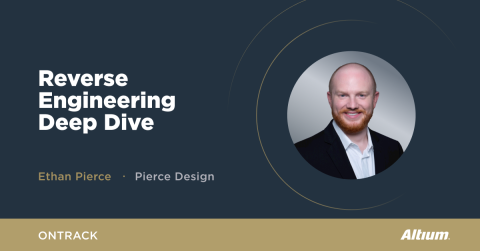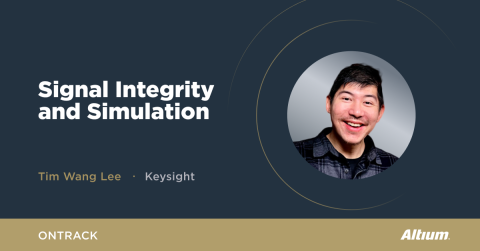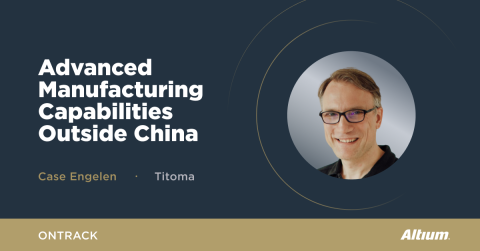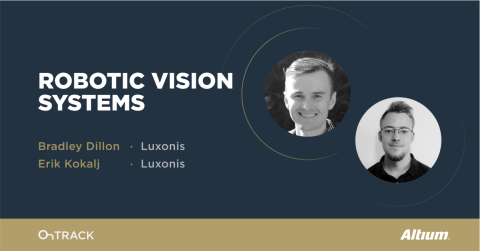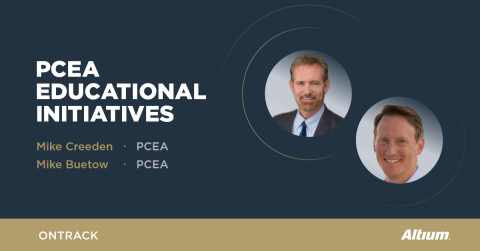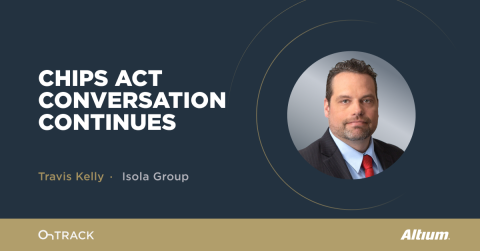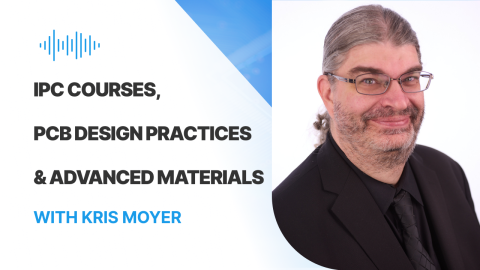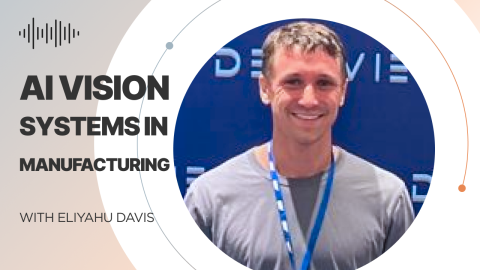Multi-board and Harness Design Capability in Altium Designer 23

It’s that time again to have Altium’s VP of Marketing, Lawrence Romine, the bearer of good news when it comes to Altium Designer’s latest features. We will discuss what’s coming in Altium Designer 23 which includes multi-board and harness design capabilities.
You don’t want to miss this one. Watch through the end and be sure to check the show notes and additional resources below.
Listen to Podcast:
Download this episode (right-click and save)
Watch the Video:
Show Highlights:
- Altium Designer®’s regular and reliable updates are incomparable in the industry, stay on top of the monthly updates through the OnTrack newsletter
- There are 3 major themes to come in Altium Designer 2023
- Multi-board systems and harness design – empower PCB designers and electrical engineers to design harnesses
- Collaboration and teamwork
- Make Altium Designer a necessity for every PCB designer – the world's greatest and most elegant design experience
- Code Designer, coming soon – the ability to work natively in Altium Designer and in Mcad tool of choice
- Multi-board and harness design capability, Altium Designer is fully supported through Altium 365
- It's never too soon to involve the other stakeholders in your PCB design
- Altium 365 releases commenting capability to both BOMs draftsman documents
- New power analysis capability powered by Keysight, anybody that can design a printed circuit board can now do some power analysis
- Altium Designer users are encouraged to check out all of the extensions, especially the new power analyzer
Links and Resources:
Connect with Lawrence Romine on LinkedIn
Stay on top of Altium Designer versions updates
What’s new in Altium 365
Read: Come See the New Power Analyzer by Keysight in Altium Designer 22.9
Connect with Zach on LinkedIn
Visit Nexar website
Visit Octopart website
Claim the special offer for Podcast listeners only
Transcript:
Lawrence Romine:
Now the ability to push and pull the entirety of the design. So to include all the boards, the harnesses, and their relative orientation to each other into the mechanical domain, make some adjustments and push those changes back into the electrical domain is also part of our Altium's Designer 23.
Zach Peterson:
Hello everyone and welcome to the Altium On-Track podcast. I am your host, Zach Peterson, and today I'm going to be talking with Altium's VP of marketing, Lawrence Romine. If you've been paying attention to the calendar, it's that time of year where we start talking about the newest version of Altium Designer and we are here today to talk about it with Lawrence. Lawrence, thank you so much for joining us.
Lawrence Romine:
Hey Zach, thanks for having me. Not to let the folks in the audience see too much behind the curtain, but the first attempt at your introduction I think was superior because in that one you were excited to be speaking with Altium's VP of Marketing, Lawrence Romine. So I hope you're still excited. I am.
Zach Peterson:
Always. Thank you so much for joining us. The new version of Altium Designer, every year comes out. It's not like the other CAD tools. Every year there's a new release.
Lawrence Romine:
There's always something cool that gets updated and I'm excited to see what's going on in the new version.:
Yeah, I mean look Zach, I'd say... I've worked at Altium a long, long time as you well know and probably a lot of your audience probably knows and I know a lot of the internal, certainly the sales folks here at Altium are tired of hearing me talk about how long I worked here, but long, long time. And I can tell you that it's 18 years. And in the early days of that we were kind of Altium who? And we did not have a real reliable cadence, no pun intended, release cycle. But I can tell you certainly in the last 10 years that absolutely our development team just in and of themselves, I would say is absolutely one of our more significant competitive differentiators, but the regularity with which we develop the product second to none, I just don't think there's anybody that could make an argument to say they're even close and certainly not make an argument that they're leading in that department.:
This is probably an area where I just don't think where anyone's even in the same neighborhood with the regularity and the reliability of our release cycle. We're releasing updates every month as you well know.
Zach Peterson:
Yeah, absolutely. And for those in the audience who don't know about the updates to features and the notifications of those updates, you can of course subscribe to the newsletter or you can go check out the What's New page. So check out the show notes. There's going to be the link to the What's New page you can learn about all of the new features. And then of course I believe there is a What's Coming page announcing stuff that is coming soon.
Lawrence Romine:
Yeah, that's an excellent point Zach. So as much as we've done just an amazing job of aligning our product development team with the marketing and selling organizations within Altium and really sort of as I said, hone them into really a significant differentiator for us, one thing we have not done a really great job of is telegraphing what the... I hate to use the word roadmap because it's so cliche, but what the future holds in the development world.:
So I am proud to say that as a matter of fact, I saw what I believe to be the release candidate for the Coming Soon page and that will, as I mentioned, we have a monthly update cycle, so that page will be updated on a monthly basis as the features move from the What's Coming to the What's New, we'll obviously need to FIFO in backfill with the new capability. So I'm excited to say that, and I suspect there's probably more than a few people in your audience that will be excited to see that as well. Gives our subscribers an opportunity to really see where their money's being invested and really get a sense of where we're taking the product, which as I've already established, and I think most people would agree, is really leading the industry.
Zach Peterson:
Absolutely. And I think one of the things that tends to happen with these release cycles, whether it's kind of on a multi-month or yearly basis is there are themes that get built into the product. So in 2020, of course during lockdowns and everything like that, the focus was really collaboration and then that's where Altium 365 was developed and released and had such huge success. But the theme at that time was collaboration and we've kind of proceeded on that for a while. So what's the new theme that is going to become the overarching tone of the new features in Altium designer?
Lawrence Romine:
So there's really three themes, major themes that we're working with. And these will be clearly articulated for anybody that visits our webpages. But those three themes in really no particular order but system design or product design as we're calling it. And really the idea there is that very few people... And actually now that I say that I look around my desk, there's a couple products that probably have a singular printed circuit board in there. But for the most part, most organizations, most engineering people now are really dealing with multiple board systems or products. And obviously those boards need to be connected with a harness. So the theme being product design, but what the big major sort of killer feature that's being released without Altium Designer 23 is in fact harness design. That's both logical and the physical design of those harnesses.:
So we really do intend to be able to obviously empower PCB designers and electrical engineers to design harnesses. Many of our customers are sort of Renaissance people in that regard, do everything. But also we see no reason why we couldn't replace some of the sort of mainstream harness design products out there without mentioning them by name. But obviously the upshot there is obviously the unification of all those design capabilities underneath Altium designer, which is obviously Altium Hallmark unified design, but obviously being able to not just design the multiple board products ,but now obviously deal with signal mismatches board -to-board and through those harnesses themselves as well.
Zach Peterson:
So you mentioned Signal Mismatches board-to-board, so I take that to mean that the harness design is logical in the schematic.
Lawrence Romine:
That's correct. That's absolutely correct.
Zach Peterson:
And so I'm going to assume that all of the features that you could access in the schematic in one board also then poured over to the other board and that could even expand to include the simulation.
Lawrence Romine:
Absolutely. Down the road, obviously... Because in the simulation department, which we do have something to reveal in this podcast as well, which I'm sure we'll get to. But just to finish off on your question, there's a couple other themes. Obviously collaboration, teamwork is really not going to go away. We really have settled on I think the word teamwork here. And the reason for that I think is, well there's a couple things. When we first went forward with Altium 365, there was a lot of our customers, Zach, as you well know, are sort of individuals that is really how Altium made a name for itself when nobody knew who we were. We really focused hard on marketing to and working with selling our products to the actual users of our product. And the byproduct of that is that we have a tremendous amount of one- seat customers.:
It's really still our bread and butter. And there was a real tendency in the early phases of Altium 365 for those customers to say, "Well, I'm a one-man show and one-person band. Collaboration's not my thing." And really that's untrue. I don't know too many people... Even if you're working out of your garage, which we have a lot of those customers and I've worked out in my garage too. I'm sure you probably have as well, Zach. I don't have a wave solder aligned in my garage. So at a minimum you're communicating with a manufacturer.:
Now the other theme is we continue this march towards really just removing any reasons whatsoever that any just mainstream hardcore PCB designer wouldn't choose Altium designer for their PCP design needs. And this is really just bringing advanced, more advanced capabilities in the PCB design domain to the forefront. So things, custom pad stacks, enhanced constraint management, improvements to the variant manager, really flipping that around. So taking much more of a system approach to variant management as well. So that really eliminates some of the manual labor associated with fitting and not fitting. And when you have many variants of a product, some additional developments on footprint parameters, things of that nature, high-end PCB features.
Zach Peterson:
So all of those little crazy ground pads that I see on some TI components are going to be really easy to do in the footprint creator.
Lawrence Romine:
That's correct. And we work with a lot of companies like TI without mentioning any names, and obviously some of these developments come from working with companies like that. Absolutely.
Zach Peterson:
Sure. I think that makes a lot of sense. And it almost seemed like for some of those pad stacks, you have to cobble together the different tools in order to get it to work. And if you didn't do it correctly, the design rules would turn on you once you get into the PCB editor. So I think that's actually really cool, this custom pad design thing.
Lawrence Romine:
Well look Zach, I've said this for years, which is I think that in the hands of a capable PCB designer, frankly, you could probably use a hammer and chisel and probably still come out with a functioning design. But obviously we want to have the world's greatest and most elegant design experience. And so for those that are pushing the limits, they shouldn't have to work around or they shouldn't have to do a work around. So the rule sets the DRC and then of course just the provisions and the tool set itself should natively support those things. And that's just a great example. As I said, we will never abandon the development of the PCB product because that's really still what we do at our core. We develop printed circuit... We develop software for those developing printed circuit boards.
Zach Peterson:
And one of the cool things about product design is it now folds in some of the existing features that I think some people just don't make enough use of, right? There's Ecad Mcad, and in my experience talking to some customers, they love Ecad Mcad. And so now it's not just the board, but it's multiple boards, the logic between them. You can do the enclosure in one of your mechanical tools and then the harness design. So where does the harness design come in? Are they actually doing that in Altium designer? Is it in a mechanical tool or is it both?
Lawrence Romine:
No, they would do the harness design in Altium designer, but some of the new capability that's coming would be now obviously from what we call our product name is Code Designer. And that's the ability to work natively in Altium designer and in Mcad tool of choice. But obviously with this new harness capability... And we've had multi board, but now gluing that all together into this product design category, now the ability to push and pull the entirety of the design. So to include all the boards, the harnesses and their relative orientation to each other into the mechanical domain, make some adjustments and push those changes back into the electrical domain is also part of Altium Designer 23.
Zach Peterson:
Well I kind of feel sorry for those folks who still have to export all their step files for board number one, board number two.
Lawrence Romine:
Can you imagine the size of those files? I know, it's probably .
Zach Peterson:
I've had to try and email some of those files.
Lawrence Romine:
Yeah, they're quite large. I don't think you'll fully appreciate the size of those step files.
Zach Peterson:
Yeah, a hundred megabyte step files. I mean it gets crazy sometimes.
Lawrence Romine:
Yeah, absolutely. So yeah, obviously co-designer itself is a provision now of Altium 365. So these are really... It's really a singular proposition when we talk about Altium Designer in Altium 365. And so development in one obviously necessitates development in the other. And this is a good example where the multi-board and harness design capability, Altium Designer is fully supported through Altium 365. So for viewing, as an example is on the development schedule, but also this co-design capability as well.
Zach Peterson:
Yeah, I really like how this all fits into bringing PCB designers into a team because after talking to some of the enterprise folks at Altium and listening to some of their past experiences working at larger companies, they had made these comments that even up to today, PCB designers are still kind of their own unit. They just do their thing and "Here's the board. Have fun guys." And everybody else just takes it.
Lawrence Romine:
No, it is, and I can tell you, I've done a lot of research in this area. So it was probably about six years ago when we were looking at co-designer itself, bringing that into the market. Maybe that's a little sooner than that... Maybe seven years, but neither here nor there. I travel around at least the U.S. and met with a lot of companies. And these were companies that were friendly to us. They were advocates. So we were able to get meetings with really their entire engineering staff. And I can tell you more than one meeting, I sat in a room, kind of in this big... If you can imagine a big table. And myself with one of our developers, Nikolai, sitting at the table and then the entirety of their engineering team. And what you would see is PCB designer folks was two or three people and then you had mechanical team, which pretty much consumed the entirety of the table.:
And the question I asked, I really got very familiar with was, "Well, when there's a dispute or a late stage mistake that's discovered... Let's say that there's a vein, a rib in the mechanical that's going to get into a capacitor or something high profile on the board, something of that nature, who wins those arguments." And it was just an open... The PCB guys and gals just lost every single one of those arguments. So it is true that they are their own sort of entity and with the collaboration or teamwork capability of bringing to the table sort of levels the playing field for them. So first of all, hopefully eliminates those late-stage gotchas, but it really allows them to work collaborative. And that MCAD code design is a great example of that. Absolutely. It's never too soon to involve the other stakeholders in your design.
Zach Peterson:
Yeah. From the front end. Absolutely, you should.
Lawrence Romine:
Which by the way, on that note, that's another area of development that we're bringing to the table too. Now that we're on that topic. We are now bringing commenting capability to both BOMs and draftsman documents. So those that aren't familiar with what a draftsman document is, it's fabrication assembly drawings. I think that's worth mentioning because that's another area where we basically created a capability within Altium designer that replaced a whole product in many organizations. We talked about creating those manufacturing and fabrication drawings. But now with this new product design theme that we have with Altium Designer 23, ability to throw those into a team 365 and just with an email address, anybody with a web browser can interact with that. So purchasing agents, obviously manufacturing partners, any people... Even they don't need an Altium designer license to do so. So that's a great example of the teamwork theme that we're doubling down on here with 365 as well as the product design capability.
Zach Peterson:
That's pretty cool that this is extending into the viewer as well because I actually know people that they love to embed their projects in their own company websites or personal websites using the viewer. And this just takes it to another level and gives them a way to showcase what they can do.
Lawrence Romine:
It's interesting you say that, Zach, because I don't think... There's few people that fully grasp that, by the way, that you can actually embed that in your website. And even if you just go to our forums as an example, if you load a file to the forum, it automatically is displayed in the thread, your design right there in the thread. And anybody that wants to do that with their own websites has the ability to do that as well. I think you do that actually, Zach, don't you?
Zach Peterson:
I have done that. Not on my site, but I have helped. I've shown people that is a capability and there are some other folks who you probably know from people who do what I do, who actually do that. Yeah.
Lawrence Romine:
Yeah, yeah. I know exactly what you're talking about. Well, and just to keep bringing back to the theme of the podcast today, at least as far as my part's concerned, in the new release, multi-board with the harness and everything will be supported in that viewer as well.
Zach Peterson:
Very cool. Very cool. So earlier when I was mentioning simulation, you had mentioned that there is some cool stuff on the horizon. And for those who have been paying attention to the website, you may have noticed that the power analyzer from Keysight just recently went out. And I wanted to ask you what else is coming on the horizon for simulation?
Lawrence Romine:
Yeah, so that's an exciting new extension, as you mentioned, that is being dropped, if we could use that term. It's being dropped with... Well, it's already out, but as we're on a monthly release cycle out Altium Designer 23 is really kind of a collection of things. So I still say it's part of Altium Designer 23, given its proximity to when we would officially start sending out Alium Designer 23. And that is a new power analysis capability that is powered by Keysight. So we worked very closely with Keysight on this. They're very excited about it, as are we. And you, Zach, as a simulation or analysis expert, really in your day job, you would know that those are really kind of... And thankfully for you, right, they're a very specialized set of skills. In many cases, PhD is required. I know you've got one.:
And I think what we are bringing to the table with Keysight is really an Altium hallmark, which is this democratization of very advanced capabilities and bringing those to the masses. And this very much speaks to that. So as I said, no lab coat. Leave your lab coat at home, no PhD required. Anybody that can design a printed circuit board can now do some power analysis. Just press a button and get those results. React on those results, press the button again and see if in fact that clears the issue. It even goes as far as to suggest some potential changes you can make. It's very visual. It's very, very simple to use. So unfortunately for folks like you, Zach, but go ahead.
Zach Peterson:
That's okay. Because for me it speeds up the workflow a little bit, which is actually just fine. I mean, because normally if you go into an external simulator, you got to export, you got to then re-import. You got to build a model around it. You have to make sure the model parameters are all there. You have to actually do a little math on the front end to make sure that your descriptization is correct. And then you go for it.
Lawrence Romine:
You got it. You got it. And if you look at that webpage, which I know you have, it says very clearly on there, "Analyze, modify, analyze without leaving your PCB editor." What you've just described is very much not that. And that's not to say that there's not a time and place obviously for that, but this really just gives anybody the ability that... Well, and frankly, everybody should be taking into consideration power, their power distribution network for field failures, potato chipping, field failures, that sort of stuff.:
And this just makes it very, very easy. And you'd be shocked. We do offer... I believe it's a two-week evaluation. If you want to go and download that extension, you can play with it for free and just load some of your previous designs in there. I think you'd be utterly shocked with what you might find. I know we did that when we were spinning it up. We just put some of our old reference designs in there that we've been shipping frankly with the product for years, since I've been around. And come to find out, those probably aren't really that robust of a design. So give it a go. I think you'd be pleasantly surprised. It's reasonably priced and it's darn effective.
Zach Peterson:
Well, sure, and I would encourage any of the viewers out there to navigate over to the extensions page in Altium designer, check out all of the extensions, but of course, check out the power analyzer as the newest extension.
Lawrence Romine:
Absolutely. We're very excited about that one.
Zach Peterson:
Well, thank you so much for joining us. Any final thoughts before we depart and go our separate ways?
Lawrence Romine:
Well, I mean, Zach, you and I don't get too far apart, but as always, when I have a chance to talk to... Directly to the users like this or our customer base like this, I always just like to say thank you because I know it might seem a little cheesy if that's a good appropriate word to use. But Altium, as I've mentioned even in the context of this podcast, Altium has really, really become the leader in this industry. And that's by really aligning ourselves with the users of the product. And I can't thank them enough for their continued sort of loyalty to the brand and loyalty to the products. And when we bring new things to the market like Altium 365... Although I would probably question them if they didn't have some skepticism when we bring these products to the market, but that skepticism usually quickly wanes. And then they're very, very much on the vanguard of adoption. And I can tell you that's what we've seen with Altium 365. And as we release new features, they're very quickly adopted by the users. And I just can't thank them enough.
Zach Peterson:
Wonderful message. And I agree with you, thank you to all the users because of course Altium wouldn't be with what it is without them. And of course, Altium has such a great philosophy of centering itself around the users, and I know the users appreciate it. As a user myself, I appreciate it.
Lawrence Romine:
Well, I appreciate you for appreciating that, Zach. So now that we all appreciate each other, I do sincerely thank all of the users and I thank you for giving us the time to talk about this new release, Zach.
Zach Peterson:
Absolutely, absolutely. Lawrence, thank you so much for being here today. Anyone that's out there listening, make sure to click over to the page on the Altium blog and check out some of the show notes. We've got some great links in there. You can learn more about the upcoming features. And of course, learn all about the features that have been released over the previous months and make sure to bookmark that because new stuff is being released on a monthly basis. And last but not least, don't stop learning. Stay on track. We'll see you all next time.


